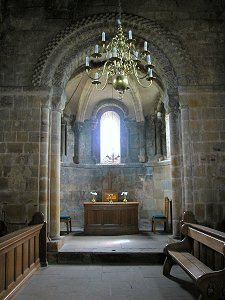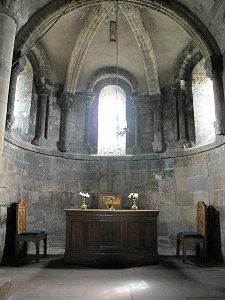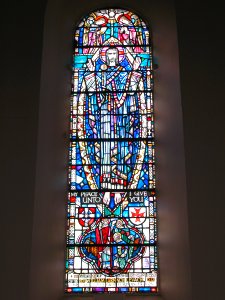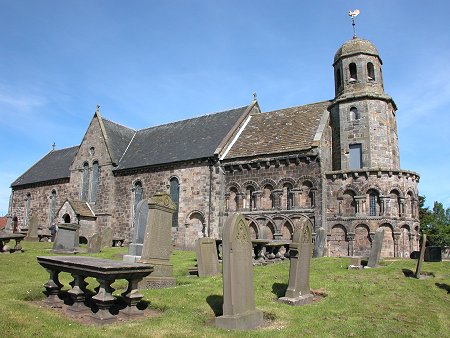 Leuchars Parish Church from the South-East |
Few churches so immediately attract your attention as St Athernase Church, Leuchars. In part this is due to its hilltop location in the centre of Leuchars, standing back from the main road and looking down on it from above a high wall and steeply sloping graveyard. But the real eye-catcher is the east end of the church, the stunningly decorated chancel and apse described by one commentator as "the second finest piece of Norman work in the whole of Great Britain".
The effect is like a wedding cake in stone, with the tower formed by a series of layers topped by an unusual pepper-pot effect. And around the lower half of the tower and the outside of the chancel is the stunning blind arcading that still looks much as it would have done to the masons who constructed it nearly 840 years ago.
The beauty of the east end of St Athernase Church is all the more remarkable because it has survived several determined efforts to destroy it. Not by the marauding English army who attacked nearby Leuchars Castle in the 1300s, but by successive waves of "improvers" who first added towers above the original apse, and then removed the original nave to make way for the stone box that even lovers of the church would call functional rather than beautiful.
Internally the real attraction of the church is reserved for its east end. The chancel and apse are simple, yet beautiful: much less ornate than their exteriors. The nave slopes gently upwards to the west, and additional seating is provided by a large gallery at the west end.
St Athernase Church was built in 1183-1187 by Robert de Quinci, a Norman who had already built nearby Leuchars Castle. It was dedicated to St Athernase in 1244: thought to be St Ethernesc, an associate of St Columba who spent his later life in Fife.
As originally constructed the church comprised the chancel you see today with to its east the apse, but with a low roof in place of the tower. To the west of the chancel was a nave, lower but longer than the chancel itself, plus a tower at its west end. Structural problems or lack of maintenance led to the collapse or demolition of the west tower some time before 1638, when repairs included the removal of the apse roof and its replacement with a stone tower to house a bell. At the same time a window was placed in the arcading in the side of the chancel.
More neglect was followed by another bout of repairs in 1745, during which the original stone tower over the apse was replaced with the pepper-pot you see today. By 1843 a schism in the Church of Scotland had placed the old and dilapidated St Athernase Church at a competitive disadvantage compared with the attractive new Free Kirk built in Leuchars. The response was to modernise St Athernase, but at the lowest possible cost.
For £200 the original nave was demolished, and the larger box-like replacement you see today erected instead. This was slightly offset to the north of the original nave, and the chancel and apse were closed off from view. Thankfully, though no longer part of the main church, work was done within the budget to conserve the chancel and apse rather than demolish them.
The re-integration of the chancel and nave was carried out in 1914 by Reginald Farlie, who also removed the chancel window inserted in the 1600s and restored the external arcading.
Today's St Athernase Church remains an active Parish Church rather than an ancient monument. It is nonetheless open to visitors daily from March to October. Entry is free, but when visiting remember that the church has to pay for its own maintenance and upkeep: so ensure you stop off at the donations box and help ensure this remarkable piece of architecture is still standing in another 830 years.
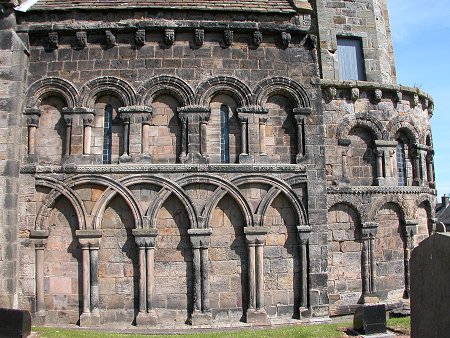 Blind Arches on Chancel and Apse |

|
|
|
Visitor InformationView Location on MapGrid Ref: NO 455 214 What3Words Location: ///mango.diner.notion |
Leuchars In Fiction
|
 The Bell Tower |
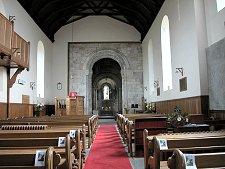 Nave Interior, Looking East |
 Nave Interior, Looking West |
 The Danger of Life by Ken Lussey (12 August 2024).
The Danger of Life by Ken Lussey (12 August 2024).
